January-February 2009

Though I’ve been in the Philippines for more than 37 years, longer than most Filipinos, I am not a Filipino nor can I ever be, even if I acquire citizenship. Filipinos whom I knew as children in Mindanao are now citizens of Ireland, my native country. Indeed, they have more rights there than I have. Though I’ve been a permanent resident here for 32 years I cannot vote, whereas my former parishioners in Ireland with the same status can vote and run for office in the local elections we hold every five years. Those who are citizens and living there can vote in all elections and even run for President, whereas I can’t.
read more...
WHAT’S IN A PHOTO?
By Fr Leo Donnelly
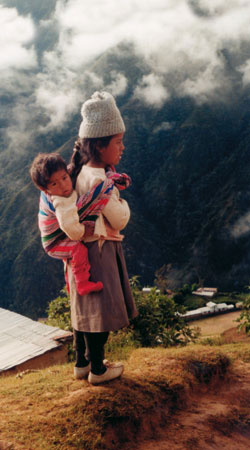
A little girl with her small brother strapped on her back gives us a glimpse of life in the mountains of Peru, especially for children. For me it stirred lots of memories, mostly good, but also some sad ones.
The little girl stands on a rise in the village of Huacuas overlooking Cotosh in the Andes Mountains.
It’s a half-hour drive just to get down to the Cotosh school, but the locals go down the hill on foot in 15 minutes. Cotosh was as far as we could travel in a jeep from the parish centre in Huasahuasi.
My Missionary Life is the Fruit of a Dream
By Marife Padao
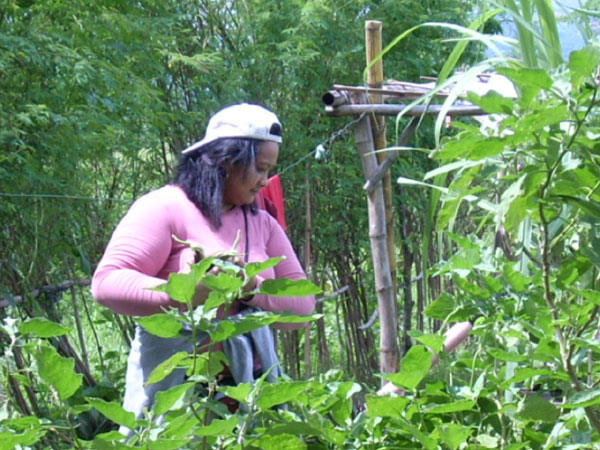 Leaving family in the province for greener pastures in the big city is quite common for a fresh college graduate to do. It was 1997 in Manila when I volunteered at the Elderly Program in Payatas, Quezon City, where the Vincentian Fathers are based. Payatas is the place where the trash slide happened in July 2000. My purpose was to acquire a volunteer certificate for future use for applying abroad while doing my self-review for the board exam.
Leaving family in the province for greener pastures in the big city is quite common for a fresh college graduate to do. It was 1997 in Manila when I volunteered at the Elderly Program in Payatas, Quezon City, where the Vincentian Fathers are based. Payatas is the place where the trash slide happened in July 2000. My purpose was to acquire a volunteer certificate for future use for applying abroad while doing my self-review for the board exam.
There I met religious people - priests, nuns, lay missionaries and seminarians. Gradually I learned to love my work and enjoy it. I forgot the purpose and the pursuit of my dream of working in a hospital abroad.
25 CENTS FROM THE POOR TO THE POOREST OF THE POOR
By Corazon Mendoza
 October 2007 I thought of asking the students in my Values Education classes to start giving 25 cents everyday for the poor. The ‘poor' I had in mind were students who can't pay their tuition fees before final examinations, when students are required to clear school obligations.
October 2007 I thought of asking the students in my Values Education classes to start giving 25 cents everyday for the poor. The ‘poor' I had in mind were students who can't pay their tuition fees before final examinations, when students are required to clear school obligations.
Simple and clear explanation of the purpose
The students of ZSNHS, Pagadian City , are a mixture of rich and poor, Christian and Muslim, but the reality is that the majority of them are poor.
What WYD Showed Me
By Gelkoff Calmerin
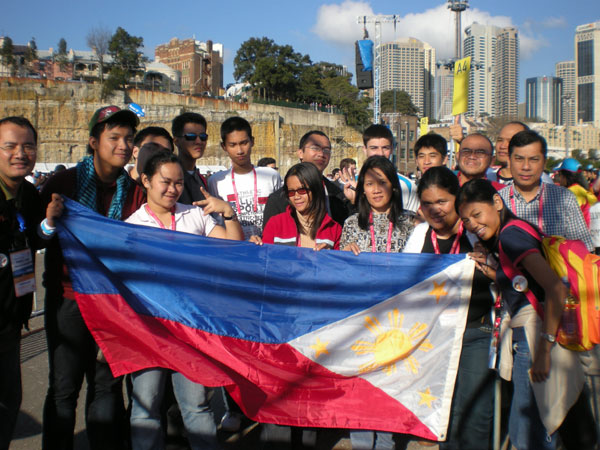 Since I joined the Columbans in 1972 I have visited 32 countries, even if some of them only very briefly. For 22 years from 1978 to 2000 I was assigned to the Islamic Republic of Pakistan.
Since I joined the Columbans in 1972 I have visited 32 countries, even if some of them only very briefly. For 22 years from 1978 to 2000 I was assigned to the Islamic Republic of Pakistan.
Living in and visiting other countries, I have known the helplessness of not having a clue what is going on around me, of not knowing what someone was saying to me, or how to ask even the most basic (and necessary) directions!
A SAFE HAVEN
By Father Gary Walker
Holy Family Home is across between a boarding school and a refuge, It is a safe haven of brightly colored walls, plants and peacefulness on the outskirts of Bacolod, a city on the sugar-rich island of Negros in the Philippines. The 40 or so girls who live there and the 15 or so college students who live in a house near the city center are from poor families who cannot afford to educate their daughters or from families in which the girls could be at risk if they were living at home.

Our Cover Story -- January-February 2009
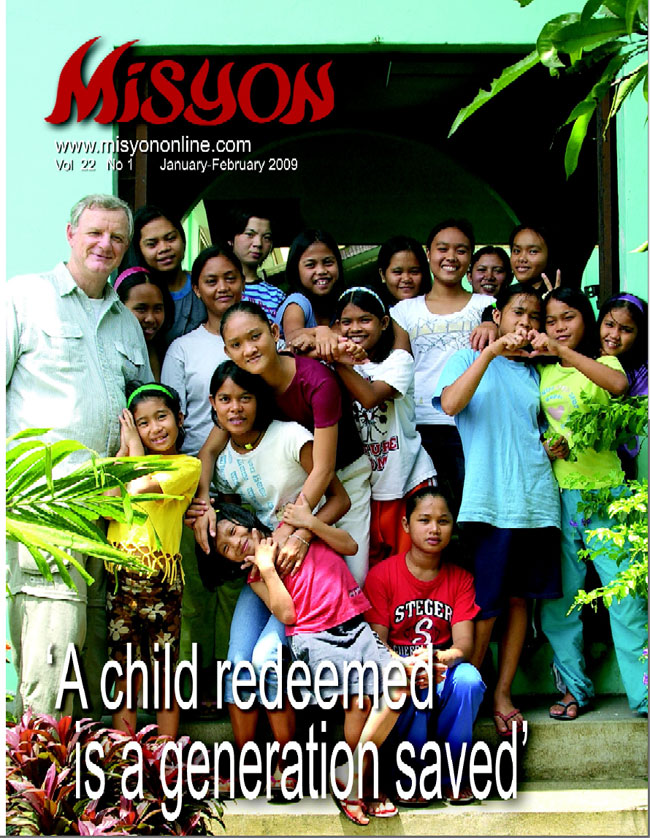
Our cover shows Fr Gary Walker with the girls of the Holy Family Home.
‘A child redeemed is a generation saved’ are the words on the gate of Holy Family Home, Bacolod City, featured in A Safe Haven.
25 Cents From The Poor To The Poorest Of The Poor
By Corazon Mendoza
The author, from Dumalinao, Zamboanga del Sur, is a teacher in Zamboanga del Sur National High School, (ZSNHS), Pagadian City . There's also a picture of the school emblem there]. She grew up in what was then a Columban parish and worked for many years in Columban parishes, often in dangerous situations.
October 2007 I thought of asking the students in my Values Education classes to start giving 25 cents everyday for the poor. The ‘poor' I had in mind were students who can't pay their tuition fees before final examinations, when students are required to clear school obligations.
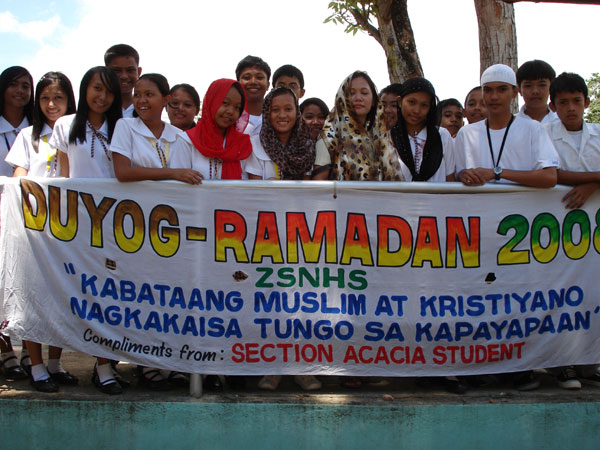
Simple and clear explanation of the purpose
The students of ZSNHS, Pagadian City , are a mixture of rich and poor, Christian and Muslim, but the reality is that the majority of them are poor. Most of them have at least a small allowance to buy a snack in the canteen. I challenged them during my Values class to save 25 cents from their one peso for the poor as a gesture of love, concern and responsibility for others. This giving of 25 cents could be a daily and voluntary form of sacrifice. The response was very positive, and in a short time we had gathered a sum of P1,000.00.
The collections
The Values student-treasurer in each class is assigned to receive the offerings. Every week I collect the money and deposit it in the bank. When I receive the money the class is informed of the amount. This is a very important part of the project.
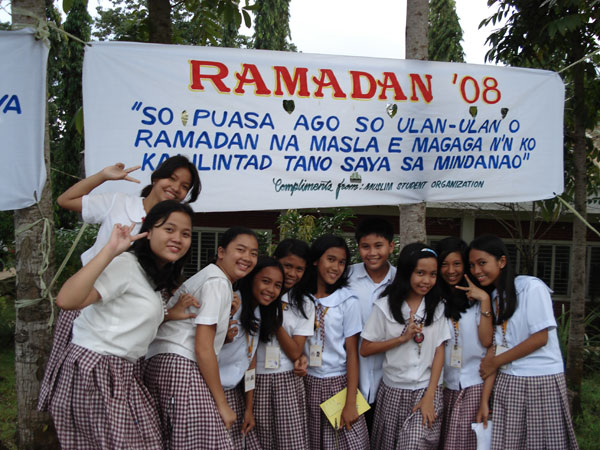
Small cans wrapped neatly with pictures of poor children
Cans with the words ‘Drop your 25 cents for us to survive', are given to some interested students to help in the collection in their respective rooms and to submit to me every afternoon before going home. Some interested teachers keep the can inside their drawer and submit it to me every week or every month. It is encouraging that a number of teachers are now helping in the collection of 25 cents.
The Proceeds
Last year's collection was used to pay in full some students' tuition fees. Based on the records, we helped 50 poor students. We also extended help for the medical expenses of a student who had cancer - unfortunately she died – and to another student who had a minor operation on his jaw. Their parents were so happy with our support and sympathy. The small amount of 25 cents meant a lot to those who were helped. Quantity is not the priority. The quality of giving and commitment are the values we, both teachers and students, desire to live.
Transparency is essential to the success of the project.
At first, I was alone trying to concretize things in my mind on how to go about it. It is really an extra burden for me but I am determined to continue and see the results. I shared the idea the another Values teacher, Annalyn Butac, and we finally agreed to help each other to sustain the project to make the Values formation in the lives of the students tangible and alive. I also informed a few teachers about the money collected and how it is used and they were appreciative and willing to help encourage their students to support the project for the poor. At present there are ten teachers who are interested and supportive in spite of their heavy work load. Most importantly, our beloved principal, Mr Roberto D. Bibanco, is behind us as he gives his consent to the students to take part in the giving of 25 centavos for a cause. Thanks God!
I experience the generosity of the young students as we only request 25 cents but on different occasions some will drop a peso, or even five pesos, in the can. It is a small project but has significant meaning and it develops desirable values in the lives of the young and gradually eradicates selfishness from their hearts.
How it has helped both students and teachers
Students slowly understand and become more aware of the needs of other students and people in the community.
They have a way to respond to others' needs even in a small amount.
More teachers are now supportive and are getting involved because they see this as a way of forming the mind and an attitude of care and concern among our students. This is a sign of a caring school community of Muslims and Christians.
After three months of the current school year we had already raised P14,184.65.
Values experienced through the project
• Transparency - Accountability for money received.
• Honesty - Money received is clearly used for the purpose for which it was given.
• Commitment- It allows and invites students to be aware of each other's need and to try to respond.
• Justice - In creating an attitude of caring.
• Love - Giving help without expecting a return.
You may email the author at crzn_mndz@yahoo.com.ph
A Safe Haven
By Father Gary Walker
The author, an Australian, is editor of The Far East, the magazine of the Columbans in Australia and New Zealand. He has worked in Fiji and Belize and also served six years as a member of the Columban General Council.

Holy Family Home is a cross between a boarding school and a refuge. It is a safe haven of brightly colored walls, plants and peacefulness on the outskirts of Bacolod, a city on the sugar-rich island of Negros in the Philippines. The 40 or so girls who live there and the 15 or so college students who live in a house near the city center are from poor families who cannot afford to educate their daughters or from families in which the girls could be at risk if they were living at home.
Columban Father Seán Coyle, the editor of Misyon, was my guide to this small but significant home when I visited him last May. May is also holiday time for schools in the Philippines.
Sr Alma Alovera TC is the director of Holy Family Home. She was on retreat the day we arrived and the girls were washing clothes. Most of the girls who live there were absent with their families because it was school holidays. However, Sister Alma came off retreat to talk with us. She is a young Capuchin Tertiary Sister of the Holy Family, one of a community of seven who run the home, from Titay, Zamboanga Sibugay, where the Sisters run Friendship Home San Francisco for girls from poor families in rural areas so that they will have the chance to go to high school. A young Chinese woman, Jin Ping, was staying with them with a view to joining their Congregation. She is now one of seven aspirants.
‘The girls go to local schools during the school year, they walk to school with the children from this local area; some of the older ones take the jeepney to Bacolod,’ said Sister Alma. ‘They have their school routine and their holiday routine. The aim of the Home is to provide a place of security and safety and to assist the girls in getting a good education.’ With obvious pride she mentioned that some of the girls had finished high school and were going to college.
The question hovers in the air about the cost of running the Home and financing the girls’ education. Sister Alma explained with a disarming smile, ‘Holy Family Home has some benefactors and Providence helps us educate the girls.’ The girls live in pleasant dormitories, each bed having at least a teddy bear or other soft animal-toys. Sister Alma said, ‘Every girl who comes to stay here receives a teddy bear on arrival.’
Father Seán Coyle supports the Home by celebrating the Eucharist, hearing the girls; confessions and visiting throughout the year.
Like any home the girls have work and play built into their daily and weekend routine. Holy Family Home has skilled people who spend time with the girls and help them to express their feelings and provide emotional support for them. Sister Alma wants it to be as much like home as possible. The girls are encouraged to look out for one another, especially the older girls for the younger girls.
There are many successful people who received little education yet succeeded in the world. But they are exceptional. Most people are not able to follow their example. Education is the key to getting somewhere, of giving people choices. Holy Family Home is giving this small group of girls that chance.
You may contact Father Gary at garywalker@columban.org.au and you may read more about Holy Family Home in this article in our July-August 2008 issue
My Missionary Life Is The Fruit Of A Dream
By Marife Padao
Marife ‘Epie’ Padao, a physical therapist by profession, is from Katipunan, Zamboanga del Sur,a former Columban parish in the Diocese of Pagadian, and is now working in the Columban parish in Dublin, Ireland.
Leaving family in the province for greener pastures in the big city is quite common for a fresh college graduate to do. It was 1997 in Manila when I volunteered at the Elderly Program in Payatas, Quezon City, where the Vincentian Fathers are based. Payatas is the place where the trash slide happened in July 2000. My purpose was to acquire a volunteer certificate for future use for applying abroad while doing my self-review for the board exam.

There I met religious people - priests, nuns, lay missionaries and seminarians. Gradually I learned to love my work and enjoy it. I forgot the purpose and the pursuit of my dream of working in a hospital abroad. I failed to concentrate on my review and instead focused myself at working with the elderly in Payatas. I was to spend a decade with them.
My life in Payatas was so colorful with my ups and downs. After two years of working, a Columban Lay Missionary invited me to join them. I asked her for a discernment of three years, and extended it for another two years, thinking of my parents. When my mother died my passion to join the Lay Mission was still there but I still had my father and I wanted him to enjoy the fruits of his labor.
Time passed and things happened. My father got married again and I was so disappointed and upset. He had promised he would not marry again. It took me years to accept that I can't change the reality.
During my reflections I realized that this was now the time to give myself a chance to enjoy my life, to give the fullness of it and to answer the call of God. There was no reason for turning back. I felt the emptiness in my life. There was still a need in my spiritual journey which I failed to have in my decade in Payatas. I gave my life for them but I forgot to think of myself – to receive in return. I AM A GIVER.
I was so happy then when I was invited for mission here in Ireland after our nine months of orientation in the Philippines. It's really a gift from God. Although I have my ups and downs, I think of God's blessings. I have the taste of the fullness of life.
I have just started my real missionary life in the Columban-run St Joseph’s Parish, Balcurris, Dublin. I will share my life and bring my Filipino values and be open to all the possibilities that may happen, living in a culture so different from my own.
I am grateful to God for giving me the opportunity to be with the Columbans, and I thank them for bringing me from pieces into wholeness again.
You may write Epie at: St Joseph’s Parish, Balcurris, DUBLIN 11, IRELAND, or email her atmfe_may@yahoo.com
Our Hideaway

‘Girls, wear skirts tomorrow!’
Alma told her story in the September-October 2003 issue of Misyon. This article is related to what she wrote then. Alma passed the Civil Service and Teachers' Board exams in 2007.
 ‘S-K-I-R-T-S!!! Not again!’
‘S-K-I-R-T-S!!! Not again!’
Announcements like this during my college days used to make my day glum. It’s not that I hated wearing skirts, but my appearance when wearing them concerned me most and thus made me crawl from shame.
One of my downfalls was that I had no self confidence when it came to my body structures. I didn’t have that ‘Coca-cola figure’ to be proud of. I just had the typical body of an Igorot with strong, robust calves and arms due to heavy work in the fields. That’s why I didn’t have the nerve to wear mini-skirts just like everybody else did. When I tried it once, it seemed that everyone was staring at me and saying in their minds, ‘Hey! Look at that. She’s got no shame at all parading those robust, scarred calves!’ Those sarcastic glares just gave me the strength to dash to my boarding house to change my clothes. So during my high school years, I had my uniform skirts tailored three to four inches below the knee to conceal my calves.
At times, I’d spent my time brooding in self-pity. Why had God made me look this way, with these shameful calves? Why hadn’t God created me just like those petite, gorgeous women on the TV and in fashion magazines? But of course I knew I couldn’t change my physical appearance and that I should have to accept it and then ask ‘what’s next?’
Zoooooooooooommmm . . . suddenly, here I am, sitting in my solitary room, paralyzed from the waist down. I’ve got my toes, but I can’t wriggle them the way I want to. I also have my feet but I cann’t stand and walk unattended. Thus, finally, I’ve had my wish come true! And that is, I already have slim calves due to atrophy but they’re useless since I can’t move out of my room to display them and boast about them.
Yes, God did give me what I’d longed for: slim calves! An unexpected gift! He just placed this gift in my lap so I just had to accept it. He didn’t give me a choice between being paralyzed, with slim, atrophied calves that get you nowhere, or strong and robust calves that can carry your weight anywhere you possibly want to. Eh? He gave me indeed my lifetime package filled with pain and a bountiful grace: an opportunity to grow out of my self-centered world.
As it slowly dawned on me, I realized that I had prayed with a wrong motive in mind with regard to my calves. Back then, when I was still on my feet, I had never been thankful and content that I had two good feet with strong calves that could carry me around. That I could dance the cha-cha, the tango, boogie, waltz, and swing for the Lord. Yes, I was never grateful for the hundred things I could accomplish for Him and for all the talents He’d bestowed upon me. It wasn’t until He bound me to this chair that I came to realize how ungrateful I was. There were many things I’d taken for granted. It was only when I’d lost them that I realized their true value.
Today, as my mind reminiscences, I’m ever so grateful that He hadn’t taken everything and that I still have good arms and hands to clap for the Lord, a sound mind to contemplate His words, clear eyesight to see and appreciate His glorious creation, ears to hear the different songs of nature and a mouth and tongue to sing with them. With all of these I can still do many things to bring glory to His name. Lastly, if I’m to be on my feet again, I don’t care if my calves will become robust again or if I’ll be limping. What matters most is that I’m using my body and talents according to the will of the Father!
You may write Alma at Kaleo, Kadaclan, BARLIG, 2623 Mountain Province.
Send us your story (500 to 1,000 words) to PO Box 588, 6100 Bacolod City or email it to us at editor@misyononline.com
Don't forget your picture. It makes the difference.
To Search Is To Find
Why do you love your parents?

Your question is such a basic and important that it is like being asked ‘Why do you love your parents?’
Spending time before Mass praying for you and asking the Lord how I could best reply to you, I found part of the answer, I think, in the words of St Paul: I am astonished that you are so quickly deserting him who called you in the grace of Christ and turning to a different gospel - not that there is another gospel, but there are some who trouble you and want to pervert the gospel of Christ. But even if we, or an angel from heaven, should preach to you a gospel contrary to that which we preached to you, let him be accursed. As we have said before, so now I say again, If any one is preaching to you a gospel contrary to that which you received, let him be accursed (Gal 1:6-9).
In other words, St Paul is so convinced of what he preaches that he tells the people of Galatia not to listen to him if he ever preaches something else.
Another passage of St Paul came to my mind also: But by the grace of God I am what I am, and his grace toward me was not in vain. On the contrary, I worked harder than any of them, though it was not I, but the grace of God which is with me. Whether then it was I or they, so we preach and so you believed. Now if Christ is preached as raised from the dead, how can some of you say that there is no resurrection of the dead? But if there is no resurrection of the dead, then Christ has not been raised; if Christ has not been raised, then our preaching is in vain and your faith is in vain. We are even found to be misrepresenting God, because we testified of God that he raised Christ, whom he did not raise if it is true that the dead are not raised. For if the dead are not raised, then Christ has not been raised. If Christ has not been raised, your faith is futile and you are still in your sins. Then those also who have fallen asleep in Christ have perished. If for this life only we have hoped in Christ, we are of all men most to be pitied. But in fact Christ has been raised from the dead, the first fruits of those who have fallen asleep. For as by a man came death, by a man has come also the resurrection of the dead. For as in Adam all die, so also in Christ shall all be made alive (1 Cor 15: 10-22).
Here St Paul is telling us a number of crucial things. One is that at the heart of our faith as Christians is our faith that God became Man in the person of Jesus Christ, that He died for us and rose from the dead. If this didn’t happen then our lives are pretty meaningless.
St Paul also reminds us that everything he has and does is by ‘the grace of God’. The word ‘grace’ means ‘gift’.
We Christians share one basic aspect of faith with both believing Jews and Muslims: we believe in one God. However, Christians believe in a God who is Three Persons, Father, Son and Holy Spirit. And only Christians believe that God became Man. The Second Person of the Blessed Trinity, the Son, became one of us, took on the whole human experience, except for sin. Yet He took on himself the burden of our sin, most of all on Calvary.
Our faith is a gift from God. Many have not received this gift, including people of good will.
Here is something Pope Benedict XVI said about this on 30 November 2005:
‘St Augustine . . . introduces a surprising and very timely note: he knows that there are also people among the inhabitants of Babylon who are committed to peace and to the good of the community, although they do not share the biblical faith; the hope of the Eternal City to which we aspire is unknown to them. Within them they have a spark of desire for the unknown, for the greater, for the transcendent: for true redemption.
‘And Augustine says that even among the persecutors, among the non-believers, there are people who possess this spark, with a sort of faith or hope, as far as is possible for them in the circumstances in which they live. With this faith, even in an unknown reality, they are truly on their way towards the true Jerusalem, towards Christ.’
In other words, every person who is honestly searching for the truth is moving towards Christ. However, Jesus has given us the responsibility of preaching the Gospel to everyone: Go therefore and make disciples of all nations, baptizing them in the name of the Father and of the Son and of the Holy Spirit, teaching them to observe all that I have commanded you; and lo, I am with you always, to the close of the age (Mt 28: 19-20).
This means that it is our responsibility to tell others about Jesus, his life, death and resurrection and that through him all people are saved. However, it is God who gives the gift of faith.
It also means that it is wrong to hold that ‘one religion is as good as another’. It’s not like choosing between ube and chocolate ice-cream. If we believe that Jesus is God who became Man and died for us on the Cross, how can we say that it doesn’t really matter whether or not He died for us? And how can we say that our faith is not the most important issue of our lives if God loves us so much?
Vocation Page
God speaks and the Church, as servant lends its voice to the Word. But God does not only speak. God also listens especially to the just, widows, orphans, persecuted, and the poor who have no voice. The Church must learn to listen the way God listens and must lend its voice to the voiceless.
Bishop Luis Antonio G. Tagle of Imus at the Synod of Bishops on
The Word of God in the Life and Mission of the Church
7 October 2008.
Is God calling you to listen to his Word and lend your voice
to the voiceless as a Columban priest?
Write Father Jude Genovia, St Columban's Mission
PO Box 4454, 1099 Manila
Tel: 02-400-4765 / 02-523-7332
Email: columbanfathers@yahoo.com
Website: www.columban.ph
WHAT’S IN A PHOTO?

A little girl with her small brother strapped on her back gives us a glimpse of life in the mountains of Peru, especially for children.
For me it stirred lots of memories, mostly good, but also some sad ones. The little girl stands on a rise in the village of Huacuas overlooking Cotosh in the Andes Mountains.
It’s a half-hour drive just to get down to the Cotosh school, but the locals go down the hill on foot in 15 minutes. Cotosh was as far as we could travel in a jeep from the parish centre in Huasahuasi.
At 5:00am we ferried some catechists to Cotosh and from there they had to walk, scaling the hills in the background. Their destinations were ten or twelve smaller villages. They had a twelve-hour walk ahead of them, hence the early start.
The catechists were accustomed to go first to the most distant village, San Antonio. They would then walk back to the others. The advantage was the other villages would be expecting their return visit.
It was from that school in Cotosh on 9 November 1993 that Sendero Luminoso, ‘Shining Path’ terrorists took away a young teacher, Lucia Ricaldi, mother of two infant daughters.
They brought her up to Huacuas, near where the little girl in the photo stands, and there assassinated her along with eleven other people from Huacuas.
At that moment, the parish catechists were lunching in Huasahuasi having finished our monthly meeting. Three of the catechists lost their parents in this massacre.
The Yachaychin brothers lost both their mother and father and their cousin lost his father. It was said afterwards their mother was killed only when she went to the defense of her husband.
It seems she pelted a stone at one of the terrorists and scoring a direct hit knocked him unconscious. In retaliation they murdered her. Another, witnessing the slaughter, ran to Huasahuasi to warn the townspeople.
Shining Path, coming out of their jungle retreat, from those hills in the background had commandeered three local potato trucks and their drivers to transport them to Huasahuasi. One of the three vehicles was a small pickup.
Tearing across country and down precipitous tracks the witness reached Huasahuasi ahead of the trucks maneuvering the switch-back tracks.
This warning meant we were out on the streets watching their steady progress down the side of the mountain. Our feelings you can imagine. Then, unnoticed, but to our apprehensive relief, an army convoy was seen coming along the river road from Tarma.
Someone from a hillside house in Huasahuasi had signaled the military presence to the approaching terrorists. The Shining Path trucks stopped high up but the pickup came on down to double check on the military presence.
On learning it was so, they cynically told the townspeople they had best withdraw as they were not carrying their identity cards.
All of this happened while the military were busy setting up their base and field radio. On 21 October 1993 the Bishop had warned us of an imminent attack.
The message was that Shining Path intended to victimize some five parishes. Huasahuasi was third on the list. In San Pedro de Cajas, famous for its tapestries, and second on that list, 48 people had just recently been murdered.
Our Bishop couldn’t pinpoint the day, but with the military arriving co-incidentally with Shining Path it became obvious military intelligence was better informed than they had disclosed to the Bishop.
The photo of the little girl and her brother stirred all of these memories.
Some twelve years later, the widower of Lucia visited me with his now grown two daughters. I had baptized them at their mother’s ‘month’s mind’ Mass.
In our Columban years in Huasahuasi between Frs Michael Donnelly, Bob O’Rourke and myself, we buried 32 people who were killed by Shining Path, including Australian Sister of St Joseph, Irene McCormack.
Fr Leo Donnelly, an Australian Columban, was in Huasahuasi from 1990-1999. He was ordained in 1957 and is still working in Peru. You may email him at ledonem@hotmail.com
What WYD Showed Me
By Gelkoff Calmerin
It was July 11 when my friends from Buklod Study Center, Bacolod City, and I left the Philippines for Australia, the host country for this year’s World Youth Day celebration. Personally, I was excited with this trip for it was my first outside the Philippines. Well, I was also pretty tired because I had my examinations just the day before we left.

Nevertheless, nothing would keep my spirits from being up. This was a once in a lifetime event. Meeting our Holy Father and hundreds of thousands of other pilgrims from around the world was really something to look forward to.
‘Everything is set, there’s no holding back’ were the words that rang in my mind when we started on this memorable journey. We took a plane from Bacolod-Silay Airport for Manila, and then took a plane bound for Hong Kong. There we took a flight to Sydney. When we arrived at our destination it was like ‘Wow! We’re in Australia, mate!’ It was a funny experience because everyone was saying ‘Mate!’ which means ‘friend’. I was also surprised with their, to my ears, English-sounding accent. What was even funnier was our efforts to try and copy that accent during our brief stay. At first we sounded really ridiculous but, unbelievably, we were able to acquire the accent in just a few days.
Australia is such a wonderful place. It is rich in natural beauty, modern technology, and different cultures too. My friend said that Australia was like a cultural melting pot where all the cultures of the world meet and mingle with each other in one big community. Though the majority are non-Catholics, I still met a lot of friendly people during my stay.
During the start of the activities, I was really surprised to see such an enormous number of people. We met different people from other countries: Indians, Mexicans, Americans, Vietnamese, Japanese, Lebanese, Chinese, Africans, Frenchmen, and of course a lot of Australians. But these are only a few to mention. We met so many more. We also met a lot of Filipinos from around the world. I even overheard someone jokingly say ‘Wow! Everybody here seems to come from the Philippines.’
We had so many activities such as discussions, debates, catechetical sessions, Masses and get-togethers. We were able to mingle with other nationalities and talk about issues concerning the faith, society and life as a whole. We even met non-Christian Chinese who were part of our group. I really appreciated their open-mindedness and their good nature as human beings. They were very friendly and jolly people.
What fascinated me most were the Masses I took part in. So many different people from around the world were united in faith. It was in those scenes that I literally saw that the people of God, though many, are one. Indeed the Church is one. Though different languages were used in the Mass there was only one message for everyone to hear. It was then that I saw that God has gathered us into one flock to draw us to Himself. We are one flock with one Shepherd who loves us so much. It was then that I saw that the Church was indeed a family. It felt like I was part of a great big family, the family of God’s people. I suddenly felt that the whole world was my home and everyone was my brother or sister.
Finally we were able to see the Holy Father. It was a great experience to see him in person. Though I wasn’t able to shake his hand, his presence was indeed such a great gift to all of us. He was like a father given to all of us by God to guide us and to make us feel and know his presence among us. His loving message to everyone showed his fatherly concern for his children. Indeed we are his children and he is our father. This is also one thing that makes us more a family.
World Youth Day was indeed a great experience. It was truly eye-opening in the sense that it has made me see the love that God has for us in a much more global sense. It has made me see that the Church indeed is a family and was never indifferent to the needs and concerns of all people.
As with our preparations for our trip to Australia, we were as excited to prepare to leave for home. We really missed our families and friends and of course our Filipino dishes. We were so happy when we arrived in the Philippines and got on with our usual lives. The only thing that was new was the inspiration of World Youth Day in our minds and hearts that we shall carry for the rest of our lives. I hope I may be able to join more World Youth Days to come.
You may email Gelkoff Calmerin at imgeff@yahoo.com
Your Turn
By Bea Paola V. Basilio

The author has since graduated from high school.
Dear Father Seán,
I am Bea Paola V. Basilio, a fourth year student studying at St Paul College of Ilocos Sur, Bantay, Ilocos Sur. I have been a subscriber to Misyon from first year till now. Our teacher in Religious and Values Education introduced us to the magazine. At first, I thought that it was just simple literary material without anything I could benefit from and purchased it just for the sake of having it.
But I was so wrong. One time when I sat in a corner at home without anything important to do, I grabbed an issue of Misyon and started to read its contents out of curiosity. Then I finally realized that it was no ordinary reading material because it contained such a treasure in the form of striking stories based on real life situations and articles that served as a guide and inspiration to life.
These stories and things done by missionaries like you who emphasize the importance of serving others without expecting anything in return. The things you are doing are well appreciated and recognized by a lot of people who are reading your magazine. It also helps us remember God’s call to mission, that we can gain eternal happiness through showing and giving love to others by rendering service without any conditions at all.
One article I read, Evangelizing Seafarers (Sept-October 2006), was about Filipinos working overseas. Many of them become seafarers who work and render service at sea. These Filipinos are far from their loved ones and families but still they never omit to continue God’s journey on mission. Questions just pour out of my head like: is it hard to become a missionary? What are the things that we can get from it?
So I came to think about the wonder of being a missionary. You get to travel to other places, discover different cultures and traditions, and meet different people with different personalities and are able to help those who are in need. But based on your articles and stories that your have shared, I learned that it requires a lot of hard work, toughness and sacrifice to become a missionary and pursue your goals.
Despite this, the joy we achieved from our service is quite priceless as long as we are sincere and we love what we are doing. So I made myself join the CEP, an outreach program in our school, where we go to places to teach, help and have fun with young children. This simple thing is very rewarding because I was able to bring a smile to those children and for sure I was able to touch their hearts as they have touched mine. Until now I continue to participate in it.
I’m so glad that I am able to do simple missions now and not just read about them in your magazine. You serve as our guide and model. Continue living and fulfilling your mission of service and love. More power to you and your magazine. Happy Holidays and may you have a prosperous new year!
Truly yours,
Bea Paola V. Basilio
St Paul College of Ilocos Sur
2nd Flr, Lahoz Bldg
Jose Singson St, VIGAN CITY
2700 Ilocos Sur